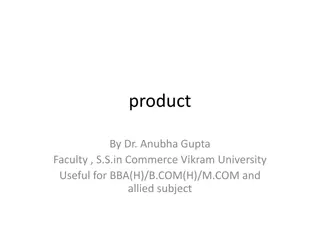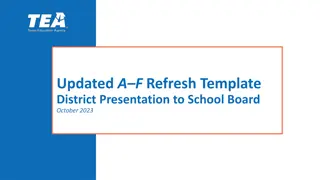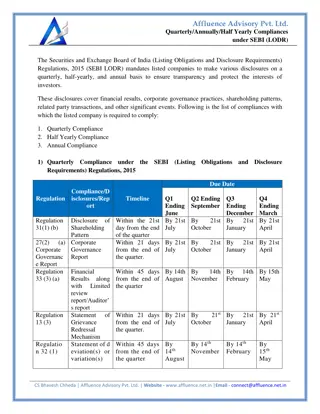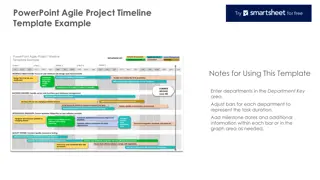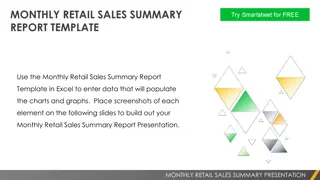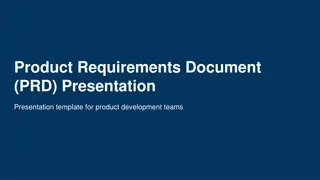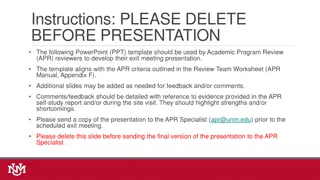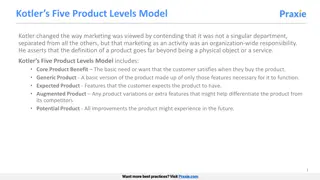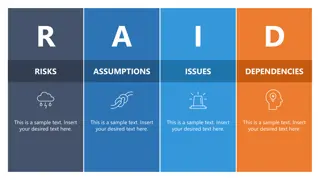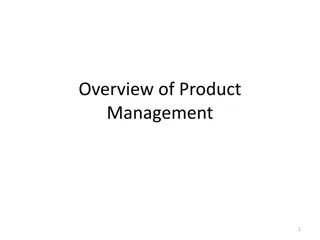Yearly Biologic Product Report (YBPR) Template Overview
The Yearly Biologic Product Report (YBPR) is a crucial document submitted annually by manufacturers of Schedule D biologic drugs, providing production information on drug substance and product lots. This report serves as a formal tool for post-market quality information, ensuring consistency, safety, and quality of biologics. Regulatory requirements and content guidelines are outlined, emphasizing the significance of YBPR in regulatory processes and product assessment.
Download Presentation

Please find below an Image/Link to download the presentation.
The content on the website is provided AS IS for your information and personal use only. It may not be sold, licensed, or shared on other websites without obtaining consent from the author. Download presentation by click this link. If you encounter any issues during the download, it is possible that the publisher has removed the file from their server.
E N D
Presentation Transcript
Yearly Biologic Product Report (YBPR) Template Martin Nemec, Ph.D. Monoclonal Antibodies Division (MAD) Biologics and Genetic Therapies Directorate (BGTD) Health Products and Food Branch (HPFB) Health Canada CAPRA Annual Education Day, June 11th2013
Presentation outline Introduction: What is a YBPR? Why we need YBPRs? Regulatory basis for YBPRs. What is in a YBPR? Our YBPR experience so far YBPR template project: Purpose, objective, expected outcomes. YBPR template: Sections, alignment of the template with guidance, scope, annotation of sub-sections. YBPR template sections in more detail 2
Introduction: What is a YBPR? The Yearly Biologic Product Report (YBPR) is a document that must be submitted annually by manufacturers of all Schedule D (Biologic) drugs, whether or not manufactured or sold within the reporting period. The document contains production information on both drug substance and drug product lots manufactured during the reporting period. 3
Introduction: Why we need YBPRs? The YBPR is formal tool used by the BGTD to obtain post-market quality information; as such it is part of BGTD s life-cycle approach to the regulation of biologics. Specifically, YBPR information is... ...used to verify the consistency of the process, to assess the on- going safety and quality of the product, and to highlight any trends. ...part of the consideration of re-assignment of a product into a different Evaluation Group. ... used to monitor progress on commitments. ... an opportunity to assess the lots marketed in Canada in the context of all the lots produced at a facility. 4
Introduction: Regulatory basis for YBPRs. The requirement for YBPR was introduced in Section 5 of Health Canada Guidance for Sponsors: Lot Release Program for Schedule D (Biologics) Drugs, which became effective in June 2005. The authority to request YBPR information derives from section C.08.007 and C.08.008 of the Food and Drug Regulations. No manufacturer shall sell a new drug unless the manufacturer has ... furnished to the Minister ... reports respecting the information described in paragraphs C.08.007... ...the manufacturer shall establish and maintain records, in a manner that enables audit... 5
Introduction: What is in a YBPR? The requirements regarding the content of YBPRs are outlined in Section 5.1.1 of the guidance document. To reduce the burden on sponsors of implementing the YBPR, the following allowance was made: A report prepared for another competent regulatory authority that contains the information outlined in sections 5.1.1.1 to 5.1.1.7 may be updated with Canadian- specific information and submitted as the YBPR. 6
Introduction: Our experience so far... Different interpretations of the guidance by the various sponsors have resulted in YBPRs containing information that is considerably divergent in content (type, level of detail) and structure (presentation, overall organization, and format). Submissions are not amenable to efficient review. Missing or incomplete information must be requested from sponsors. Required information must be extracted from the submission and responses to information requests, collated, and documented in a separate report for future reference. A YBPR is required for every Schedule D product with an active DIN, which amounts on an annual basis to hundreds of submissions, with new products being added each year. Workload is a challenge. 7
YBPR template project (1) Purpose The intent is to facilitate both the preparation and the review of YBPR, by minimizing superfluous information, information gaps, and time to locate specific information through consistent presentation. Objective The goal is to develop a template that reflects the consensus by the BGTD reviewers on the interpretation of the YBPR guidance, focusing on the type of information required, the level of detail, preferred presentation of the data, and overall organization. The template is to be completed by sponsors, and submitted in electronic format. 8
YBPR template project (2) Expected outcomes Sponsors get a clear guidance on BGTD s expectations regarding the YBPR document. Harmonized, streamlined YBPR document facilitates the review of submitted information. The improved review efficiency results in enhanced timelines that enable meaningful communications with sponsors regarding identified issues. Reviewer s comments can be inserted directly into the YBPR document, which forms the backbone of the review report thus obviating the duplication of effort. A common format and structure would increase ease of information retrieval from YBPR review reports for use as supporting documentation in related submissions or for other decision making processes. 9
YBPR template sections 1. Facilities information 2. Production information on drug substance and drug product lots 3. Information on analytical method performance 4. Summary of changes 5. Test results 6. Stability studies 7. Analysis of adverse drug reactions attributable to product quality 8. Product recall and corrective actions 9. Certified Product Information Document (CPID) 10
Alignment of YBPR template and guidance (1) YBPR template YBPR guidance 1. Facilities information 5.1.1.4 Facility information: a review of regulatory actions taken by competent authorities that affect GMP status 2. Production information on drug substance and drug product lots 5.1.1.1 Production information on both drug substance and drug product lots: number of lots produced for or sold on the Canadian market number of lots produced or sold internationally, from facilities licensed to produce lots for Canada number of lots reprocessed from facilities licensed to produce lots for Canada a review of all commercial lots intended for Canadian and international use that failed to meet established specifications, or were aborted due to manufacturing process failures, including those having been determined as having failed through studies, investigations and tests conducted by the manufacturer or reported to him by any person a concise, high-level review of critical deviations or non- conformances, related investigations, and resolution / corrective actions 11
Alignment of YBPR template and guidance (2) YBPR template YBPR guidance 3. Information on analytical method performance 5.1.1.2 Information on drug substance and drug product test methods frequency of retesting due to out-of-specification, including clarification on the reason for retesting frequency of invalid tests for stability-indicating test methods 4. Summary of changes 5.1.1.1 Production information on both drug substance and drug product lots a review of all changes carried out to the process or analytic methods. a list of changes to raw material suppliers and changes to non- compendial specifications. 5. Test results 5.1.1.3 Information on drug substance and drug product test results: a review of critical in-process controls and finished product results trend analysis for stability-indicating test methods 12
Alignment of YBPR template and guidance (3) YBPR template YBPR guidance 6. Stability studies 5.1.1.3 Information on drug substance and drug product test results: a review of results of ongoing stability program(s) 7. Analysis of adverse drug reactions attributable to product quality 5.1.1.5 Analysis of Adverse Drug Reaction Reports (Canadian and International) received by the manufacturer attributable to product quality 8. Product recall and corrective actions 5.1.1.6 All product recalls including the reason for the recall and a summary of any corrective actions taken 9. Certified Product Information Document (CPID) 5.1.1.7 If changes affecting the CPID have been made, an updated CPID (annotated and non-annotated, hard copy and electronic) is to be provided with the YBPR 13
Scope of the YBPR template information (1) The template should include information on every approved product associated with the above proprietary/brand name; facility involved in the manufacture or testing of each approved product; batch/lot of approved product, initiated during the current reporting period, whether intended for Canadian or international market, and test performed, during the current reporting period, for lot release, in-process, or stability assessment of each approved product. 14
Scope of the YBPR template information (2) For the purposes of the template, a product includes drug substance, i.e. formulated or pre-formulated bulk drug; drug product units, i.e. formulated drug in primary packaging; and drug product kits, i.e. drug product units incorporated into secondary packaging containing e.g. packages comprising vials of lyophilized product and vials of diluent or packages containing multiple single-dose units. 15
Annotation of sub-sections Where a product is manufactured by multiple approved processes (e.g. drug substance at 5,000 L and 10,000 L scale, 100 mg in vial or pre-filled syringe) or at multiple facilities (e.g. 100 mg vial at ABC and XYZ)... ...the information must be reported separately and clearly identified using the product type and/or facility name, respectively (e.g. Drug product (100 mg vial / ABC) . 16
1. Facilities information Purpose: ... to confirm the accuracy of Certified Product Information Document (CPID) currently on file at Health Canada, and to establish the scope for information to be provided in this report. Sub-sections: 1.1 Drug substance 1.2.1 Drug product unit 1.2.2 Drug product kit 17
2. Production information on drug substance and drug product lots (1) Sub-sections: 2.1 Drug product lots sold on Canadian market 2.2 Lot disposition 2.3 Reprocessed lots 2.4 Reworked lots 2.5. Critical deviations and non-conformances 18
2. Production information on drug substance and drug product lots (2) Sub-sections: 2.1 Drug product lots sold on Canadian market 2.2 Lot disposition 2.3 Reprocessed lots 2.4 Reworked lots 2.5. Critical deviations and non-conformances 19
2. Production information on drug substance and drug product lots (3) Sub-sections: 2.1 Drug product lots sold on Canadian market 2.2 Lot disposition 2.3 Reprocessed lots 2.4 Reworked lots 2.5. Critical deviations and non-conformances overview of the event, and reference to Section 2.5 of this template, which describes associated deviation(s) and corrective and preventive action(s) For each affected lot provide: lot number manufacturing step where event occurred 20
2. Production information on drug substance and drug product lots (4) Sub-sections: 2.1 Drug product lots sold on Canadian market 2.2 Lot disposition 2.3 Reprocessed lots 2.4 Reworked lots 2.5. Critical deviations and non-conformances For each affected lot provide: lot number facility name product type reason for reprocessing overview of reprocessing steps regulatory status in Canada, and whether lot sold in Canada. Reprocessing is procedure, developed, validated, approved, and documented in a batch record for use under anticipated extraordinary circumstances, whereby a lot of process intermediate or finished product is re-introduced into the routine manufacturing process and subjected to one or several steps. 21
2. Production information on drug substance and drug product lots (5) For each affected lot provide: lot number facility name product type reason for reprocessing overview of reprocessing steps regulatory status in Canada quality assessment of reworked lot, and whether lot sold in Canada. Sub-sections: 2.1 Drug product lots sold on Canadian market 2.2 Lot disposition 2.3 Reprocessed lots 2.4 Reworked lots 2.5. Critical deviations and non-conformances Reworking is a procedure, developed in response to a specific unanticipated event, whereby a lot of process intermediate or finished product is subjected to one or several steps that may differ from the routine manufacturing process. If deemed appropriate, additional studies are performed to confirm that the quality of reworked material was not compromised (e.g. extended product characterization, stability studies). 22
2. Production information on drug substance and drug product lots (6) Sub-sections: 2.1 Drug product lots sold on Canadian market 2.2 Lot disposition 2.3 Reprocessed lots 2.4 Reworked lots 2.5. Critical deviations and non-conformances 23
3. Information on analytical method performance (1) Sub-sections: 3.1 Invalid lot release and stability tests 3.2 Retesting due to out-of-specification (OOS) test results 24
3. Information on analytical method performance (2) Sub-sections: 3.1 Invalid lot release and stability tests 3.2 Retesting due to out-of-specification (OOS) test results 25
3. Information on analytical method performance (3) Sub-sections: 3.1 Invalid lot release and stability tests 3.2 Retesting due to out-of-specification (OOS) test results A summary of causes resulting in unconfirmed (false) OOS test results, including the associated corrective and preventative actions. 26
4. Summary of changes Sub-sections: 4.1 Manufacturing process and controls 3.2 Raw material suppliers and non-compendial specifications 4.3 Analytical methods 27
5. Test results (1) Sub-sections: 5.1 In-process test results 5.2 Lot release test results 28
5. Test results (2) For each test provide in the Appendix control charts (indicating acceptance limits, mean, and standard deviation) representing all lots manufactured during the current reporting period. Sub-sections: 5.1 In-process test results Critical in-process control tests as defined in CPID. 5.2 Lot release test results If trend or shift is detected, provide in the Appendix tabulated summary of the data, including the status of relevant investigations. 29
5. Test results (3) Sub-sections: 5.1 In-process test results 5.2 Lot release test results For each test provide in the Appendix control charts (indicating acceptance limits, mean, and standard deviation) representing all lots manufactured during the current reporting period. If trend or shift is detected, provide in the Appendix tabulated summary of the data, including the status of relevant investigations. 30
6. Stability studies (1) Sub-sections: 6.1 Stability lots 6.2 Stability test results 31
6. Stability studies (2) Initiated, ongoing, or completed during the current reporting period. Sub-sections: 6.1 Stability lots Drug substance Drug product 6.2 Stability test results 32
6. Stability studies (3) Sub-sections: 6.1 Stability lots 6.2 Stability test results o For each lot provide in the Appendix a graphical representation of available stability data (one figure for each test), including acceptance criteria, the regression line, and suitable confidence intervals. o If a trend is detected, provide in the Appendix tabulated summary of the data. o Where appropriate, provide a statement regarding current stability program commitments, and changes to shelf-life, cross- referencing relevant submission control number. 33
7. Analysis of adverse drug reactions attributable to product quality Provide a list and an assessment of Canadian and international adverse drug reaction (ADR) reports received by the sponsor during the current reporting period and deemed to be linked or potentially linked to product quality. A clear statement should be provided if there were no ADRs related to product quality received during the reporting period. 34
8. Product recall and corrective actions Provide a list of product recalls issued during the current reporting period, including for each o the cause o the issue date o the list of implicated product lot numbers identifying those distributed in Canada, and o a summary of resulting corrective actions. A clear statement should be provided if there were no recalls issued during the reporting period. 35
9. Certified Product Information Document (CPID) Provide a confirmation that the changes implemented during the current reporting period either did not necessitate the revision of CPID or are captured in CPID version currently on file at Health Canada, cross-referencing the version number and relevant submission control number. If necessary, provide an annotated and clean copy of the revised CPID. 36
Thank you for your attention! Questions? 37






